U.S. Department of Transportation
Federal Highway Administration
1200 New Jersey Avenue, SE
Washington, DC 20590
202-366-4000
The greatest value of an effective incident response program is realized at the scene of an incident. It is at the incident scene where strategic plans evolve into tactical activities and onscene operations. The tactical and onscene operations address the activities of responders at an incident site and the onscene coordination of the various responders. The scan team learned a great deal about onscene incident response practices in the four countries visited and the degree of tactical coordination that takes place during an incident. This chapter describes the team's recommendations on tactical and onscene operations. Recommendations address incident responders, clearance practices, tactical considerations, dispatch practices, response times, and road users upstream of incidents.
A significant amount of the information the European hosts presented related to various aspects of incident responders. These include responder safety, responsibilities, procedures, operational relationships, and other factors. The team has more recommendations addressing incident responders than any other category.
The team learned of several examples in which transportation agency or road authority personnel were involved in responding to incidents, and some have been described previously in this report. The Highways Agency in England has traffic officers who provide traffic control support to the police responding to an incident on a motorway. The IM+ program in the Netherlands has several incident response specialists involved in various aspects of incident response. Finally, the Swedish Road Authority uses the Road Assistant as a service patrol on the ring road around Stockholm. These service patrols use a specialized vehicle with several unique features (described in Chapter 6). The team believes that greater involvement of transportation agency personnel as key players in incident response programs would improve the effectiveness of response efforts. Accordingly the team offers the following (Recommendation 7).
| Recommendation 7: Role of Transportation Agency Personnel |
|---|
Transportation agency personnel should assume an aggressive role in responding to incidents as a part of operating the transportation system. The team observed several examples in which agency personnel provided services that included using service patrols to assist motorists, providing traffic control for incidents, and removing vehicles and cargo from the roadway. |
The team found a well-defined command structure in several countries, through pre-incident planning (such as the police having overall command at all incidents) to onscene command coordination (such as that practiced in the Netherlands) in which all commands met within 15 minutes of arriving on the scene to develop a unified command. The team also learned that commanders and command vehicles were typically well defined through the use of green vests for commanders and green lights for command vehicles. The team suggests the following recommendation related to command structure.
| Recommendation 8: Incident Command and Coordination |
|---|
Develop national guidance that addresses the issues of command and coordination of incident responders for a wide range of incident types. The guidance should address the following:
|
The team learned of several incident response practices that emphasize the safety of responders, victims, and road users. Some of these safety principles are well known in the United States, but the team found more widespread adoption of these principles in Europe. Specific examples include the use of high-visibility garments, use of a buffer zone, and various aspects related to responding vehicles.
High-visibility garments are widely used in Europe. While the actual design of these garments varied among responders, the team observed such garments being used by police, traffic control specialists, EMS, and others. Figure 6 provides a few examples of the high-visibility garments observed during the visit. The team was impressed by the widespread use of these safety garments and recommends greater use in the United States as follows.
| Recommendation 9: High-Visibility Garments |
|---|
Develop national guidelines on the use of highvisibility garments at incident sites. The guidelines should address the following:
|
Figure 6: Examples of high-visibility garments for responders
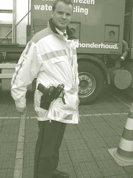
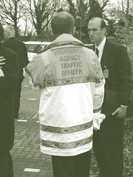
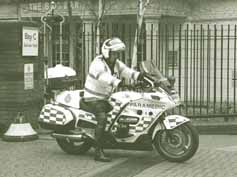
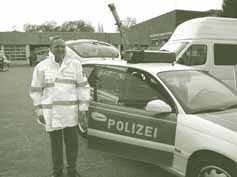
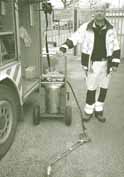
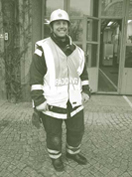
The team learned that incident responders have well-defined plans for traffic control at incident sites. In the Netherlands, for example, the incident management manual defines a 1-meter buffer zone between the working area and moving traffic. While this is a well-defined practice in temporary traffic control zones in the United States, its application has not been widely implemented in incident response zones. Therefore, the team offers the following recommendation on buffer zones at incident sites.
| Recommendation 10: Buffer Zone |
|---|
Revise Chapter 6I of the Manual on Uniform Traffic Control Devices to improve the safety of incident responders by separating moving traffic from the incident response area. The guidelines should protect responders by defining clear, or buffer, zones near moving traffic that responders should not occupy. |
Response vehicles are a necessary part of the incident response equation. The larger the incident, the larger the number of response vehicles that will come to the scene. The team found several examples in which the host countries have developed guidelines for positioning response vehicles at an incident site, markings to increase the visibility of response vehicles, and the use of emergency vehicle lighting at a site. Figure 7 provides examples of vehicle markings for a wide range of vehicles observed during the study. Figure 8 illustrates the use of retroreflective dots to define the shape of the vehicle at night for approaching vehicles. These dots are coordinated with the overall vehicle color so that they are not visible in daylight. The team also learned that some hosts had guidelines for using vehicle emergency lighting at an incident scene, but the team did not receive copies of these. Only the shielding vehicle uses emergency lighting; the remaining vehicles onsite turn their emergency lights off. Discussions with fire department personnel in Germany indicated that volunteer personnel were not allowed to drive personal vehicles to the incident site. They were required to park at an offsite location where official vehicles could pick them up and transport them to the incident scene.
Figure 7: Examples of vehicle markings






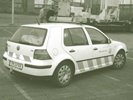
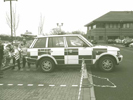
Figure 8: Retroreflective dots used to define vehicle shape

Given the findings of the trip on response vehicles, the team recommends the following.
| Recommendation 11: Visibility and Positioning of Response Vehicles |
|---|
Develop national guidelines to improve the visibility and positioning of vehicles responding to incidents. The guidelines should address the following:
|
In the Netherlands, the team learned of a product that could increase the safety of fire fighters using extrication equipment to free trapped victims. Many modern cars present potential hazards to personnel using extrication equipment if cuts are made at inappropriate locations on a vehicle. For example, high-pressure cartridges for airbags, electrical power systems in hybrid vehicles, high-strength components, and airbag sensors could all present a safety hazard to an operator. Responders in the Netherlands use a software package that identifies hazard locations on specific vehicle models so that they know what areas of the vehicle to avoid when using extrication equipment. The program, Crash Recovery System® from Moditech, displays a top and side view of the vehicle, indicating the safety features in various color schemes.10 The team recommends that similar information be provided to responders as follows.
| Recommendation 12: Safety of Incident Responders Using Extrication Equipment |
|---|
Provide responders with information that will allow them to avoid using extrication equipment on areas of a vehicle that could present a safety hazard to responders if cut using the equipment |
The European countries the team visited have incorporated several unique features and capabilities into some of their incident response vehicles. Examples of these include the following:
Some of these enhancements could be incorporated into U.S. practices. The team suggests the following recommendations as response vehicle enhancements.
| Recommendation 13: Enhancements for Incident Response Vehicles |
|---|
Identify response vehicle enhancements that could improve the capabilities and effectiveness of responders. Potential enhancements include the following:
|
The team found that transportation agency incident responders had some degree of increased authority in England and Sweden. For example, in Sweden, service patrol vehicles were equipped with emergency lighting and sirens similar to police vehicles that helped the responding vehicle to get to the incident site faster. In England, Highways Agency traffic officers could remove a vehicle without the owner's permission. The team believes that providing transportation agency responders with increased authority could have great value in improving response time, clearance time, and traffic control. The team offers the following recommendation.
| Recommendation 14: Increased Authority for Transportation Agency Personnel |
|---|
Consider giving transportation agency responders greater authority to help them arrive faster at incident sites and better manage traffic at the sites. Traffic control responsibilities should be assumed by transportation agency personnel with specialized training in traffic control at incident sites. The guidelines should include the following:
|
The team learned about several practices that help reduce the time required to clear an incident site and return it to normal traffic flow. The team believes that some of the observed practices could improve clearance of incidents in the United States, and suggests several recommendations on clearance practices.
England has two types of recovery: statutory and nonstatutory. Statutory clearance takes place when a vehicle presents an obstruction, is in a dangerous position, or has been abandoned. In these situations, the vehicle can be removed without the owner's permission. Otherwise, the vehicle is removed by the owner's auto club or by other arrangements made by the owner. In both England and the Netherlands, guidelines identified the maximum time a vehicle could be on the shoulder before it would be removed. The team also learned that the mandatory towing fee for this type of removal was typically much greater than the annual cost of a membership in an automobile club that provides free towing, creating an incentive to belong to an automobile club.
The team learned that Germany has a national highway police agency whose officers have specialized training in clearance practices, particularly on what equipment is needed to clear a site and when to salvage spilled cargo versus clearing it without regard for its salvage value.
Greater reliance on private-sector towing and recovery services in the United States would benefit from national guidance on certification and qualification criteria, such as that used in England, Germany, and the Netherlands.
| Recommendation 15: Procedures for Restoring Roadway Capacity |
|---|
Develop national guidelines that address removing vehicles from an incident scene without the owner's permission so that the roadway can be cleared in a timely manner. This includes removal of disabled vehicles on the shoulder. The guidelines should address the following:
Develop national requirements and processes for certifying private incident responders such as towing companies, auto club service patrols, and private ambulance organizations. |
Some speakers mentioned that their countries had specific guidelines for clearance times for different types of incidents, although the team was not provided with specific information about those guidelines. Having specific guidelines would help to identify the resources needed for a particular incident.
| Recommendation 16: Clearance Time Targets |
|---|
Develop recommended clearance time targets for typical incident types and recommended procedures for achieving those targets. |
In most cases, the time required to clear an incident is longer if there is a fatality. A medical official may be required to declare the victim officially dead or a thorough criminal investigation may need to be conducted. In Germany, the Netherlands, and Sweden, responders may remove the entire vehicle with the deceased victim still inside to an offsite location where the victim can be removed and the investigation continued. The team also learned that EMS personnel in Germany (where a doctor is usually at the scene) and the Netherlands are empowered to officially declare a victim dead. These procedures help open the roadway to traffic sooner.
| Recommendation 17: Removing Fatalities from Incident Site |
|---|
Develop policies to relocate deceased victims from the incident scene in a more timely manner. Potential improvements include the following:
|
The team members perceived that the countries visited had a relatively consistent approach to coordinating onscene response. In particular, the team found that in the Netherlands traffic incidents are treated in a similar manner irrespective of which agency is the initial responder. While there were certainly some differences in approaches between countries, the team found similar tactical approaches and recommends the same for the United States.
| Recommendation 18: Coordination of Tactical Response |
|---|
Tactical response plans should be developed that will promote consistent response to traffic incidents irrespective of which organization is the first to respond. |
The team found that Germany dispatched multiple responding agencies or types of responders to an incident scene before getting an onscene report identifying the resources needed for the response. This practice can reduce the time required to clear an incident and restore normal traffic flow. The team also learned that preplanned response assignments identify which units to dispatch to an incident based on the type of incident. These assignments are scalable from small to large incidents. Also, the team observed close coordination between dispatch centers and towing and recovery responders. The team recommends that these practices be considered in the United States as indicated below.
| Recommendation 19: Response Dispatch |
|---|
The following dispatch practices should be considered for implementation in the United States:
|
As in the United States, the team found that in Europe some incidents can create queues where travelers may be stranded for hours with no escape opportunity. Germany and the Netherlands have established programs to address the welfare of those stranded in queues for long periods by providing water, food, and other support services. The team believes that U.S. practices could better consider the needs of users upstream of incidents through the following recommendation.
| Recommendation 20: Welfare of Road Users Upstream of Long-Duration Incidents |
|---|
Agencies/organizations should give attention to the welfare of those involved in long-duration queues resulting from an incident. |
The team also found that several host countries have procedures for warning upstream road users of the approaching end of queue. Figure 9 provides an example of the types of end-of-queue warning and lane closure vehicles used in Germany. The end-of-queue warning vehicle (vehicle on the left in the figure) will position itself just upstream of the congestion to warn high-speed vehicles that they are approaching slower traffic. This vehicle has a warning sign on top that says "stau," which roughly translates to "backup." The vehicle will move upstream or downstream to maintain the same relative position with the end of the queue. The team believes that this practice has value and recommends it for use in the United States.
| Recommendation 21: End-of-Queue Advance Warning |
|---|
Onscene traffic control should provide end-of-queue warning to inform road users before they reach the end of the queue. |
The team found widespread use of preplanned diversion routes on the motorways in several countries. These diversion routes are identified with symbols on permanent signing, so when a diversion route is put into effect, motorists need only to be told to follow a particular symbol. This reduces the effort needed for traffic control near the scene of a major incident. Figure 10 illustrates a diversion route symbol on a roadway. The team offers the following recommendation on preplanned diversion routes.
Figure 9: German end-of-queue warning vehicles

Figure 10: Example of permanent diversion route symbol sign

| Recommendation 22: Preplanned Diversion Routes |
|---|
Agencies should develop preplanned diversion routes on high-volume freeways that would allow traffic to divert to alternate routes with minimal effort and reduce the demand for onscene traffic control. |
As previous scanning teams had observed in Europe, the team found the use of variable speed limits an effective means of controlling traffic upstream of an incident site. On motorways in England, Germany, and the Netherlands, overhead gantries at regular intervals have a variable message sign above each lane capable of displaying a speed limit for that lane. Figure 11 illustrates one of these signs. Variable speed limits could be useful in the United States, and the team offers the following recommendation.
Figure 11: Example of variable speed limit in Germany

| Recommendation 23: Variable Speed Limits |
|---|
Evaluate the use of variable speed limits as a means of slowing traffic upstream of an incident and moving traffic out of lanes blocked by the incident. The variable speed limit concept should be technology independent and focus on the ability to change speeds and not the technology for changing speeds. |
| << Previous | Contents | Next >> |